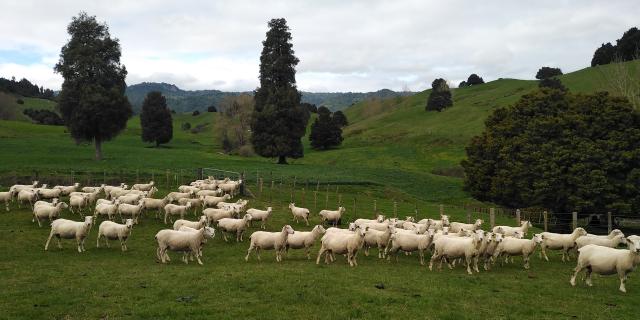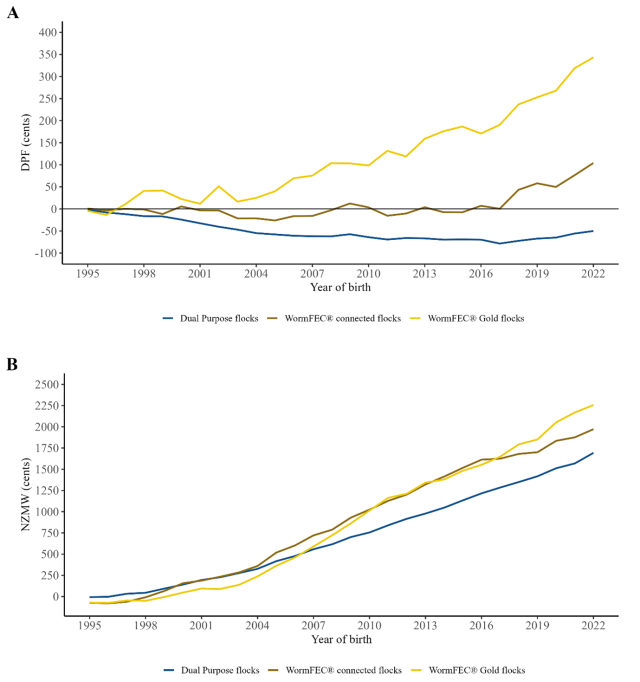What’s the story with genetics for worm management? Aren’t worm-resistant sheep poor performers? What’s the difference between resistance and resilience? Who’s CarLA (hint: It’s not your sister’s mate from Temuka).
- Resistant sheep have high immunity to worms and pass less worm eggs in their faeces.
- Resilient sheep continue to grow and perform despite worm challenge.
- Both traits are being measured and selected by NZ sheep breeders – you can buy rams that will improve these traits in your flock. Watch this video: Questions to ask your ram breeder about worms.

Photo: ewes from a high-index worm resistant flock pre-lamb.
Back in the day
- Before the first white (Benzimidazole) drench, there must have been plenty of sheep and cattle that were able to live with worms.
- Stock performance wasn’t as high, but the better animals must have been either resistant or resilient to worms.
- However, the mob production responses to using drench were so big that once we had this tool, all animals got treated regardless.
- So we’ve always had animals with the genetics to cope better, but until recently, only a handful of sheep breeders were actively selecting for worm-related traits. Work is much more limited in cattle.
Resistance
Breeding for ‘resistance’ means selecting for animals with a low faecal egg count (FEC).
Sheep that have been selected for resistance to worms based on a low FEC:
- May have fewer worms that are smaller and lay less eggs.
- Will contaminate pastures less.
- Ewes will have a lower peri-parturient rise. Watch this video to learn more.
- Lambs generally require less drenches in their first year of life.
Breeders actively measuring and selecting sheep with a low FEC are part of the WormFEC programme (PDF, 37.5 KB). Elite breeders can be classified as WormFEC Gold. Learn more about WormFEC through the following resources:
You can refine your search for a breeder by using nProve, to also choose the breed and other traits you want to include in your selection decisions. Watch this introductory video about nProve to find out more.
The heritability is about 0.18. Heritability is the proportion of the variation between animals that can be accounted for by their genetics.
When breeders first started selecting for resistance, there was a drop in some of the productivity traits such as lamb growth. Dagginess tended to increase if it was not culled for. We are well past that early stage.
The negatives from selecting for low FEC have been counteracted by using index selection for high production and low FEC. There are now sire rams available that are genuinely high performers in the standard production traits but also have a high level of resistance to worms.
The below graph show genetic progress in maternal production traits.
WormFEC Gold flocks versus average of all dual-purpose flocks

Genetic trends graphs for Dual-Purpose FEC (A) and New Zealand Maternal Worth (NZMW) (B) indexes in all Dual-Purpose flocks (n=396, which includes WormFEC® recording flocks), WormFEC® connected flocks (n=67) and WormFEC® Gold flocks (n=18) only. Indexes are presented as cents per ewe lambing.
There can be production benefits in resistant flocks arising from the lowered pasture contamination. Even non-resistant sheep running with resistant ones are likely to benefit from a lower larval challenge. It works even better if they’re well-fed too!
At a farm level, the reduced number of parasite eggs shed by the resistant animals should also lower the number of infective parasite larvae available on the pasture. The reduction in pasture larval challenge can result in better production, alternatively drenching frequency could (and should, to reduce selection for drench resistance) be reduced resulting in savings of chemical and labour.
CarLA Saliva Test
‘CarLA’ stands for ‘carbohydrate larval antigen’. CarLA is a type of antibody we can measure in the saliva of sheep as they become immune to worms. Find out more through these questions and answers (PDF, 535 KB).
Lambs with high and early CARLA responses have lower FECs and higher liveweight gains under worm challenge.
Selection for resistant animals using CARLA decreases average faecal egg count at about half the rate as selecting on FEC directly. However it has a good heritability of 0.3.
But as CARLA has more positive associations with growth and productive traits than does low FEC, it can be an easier option for breeders.
WormFEC breeders may not do this because their ram hoggets will be under deliberate worm challenge in their first autumn. Though some view this as a positive – selecting at the second stage gives longer for culling on structural and other traits that develop over time.
Flocks selecting for CarLA (PDF, 448 KB)
In commercial flocks, and on the ewe hogget side in stud operations, the value of CARLA lies in removing the very low and slow responders; who are likely to remain more susceptible to worms throughout their lifetime.
Resilience
Resilient animals are those that can remain productive under worm challenge. They may or may not have a low faecal egg count (FEC).
Selecting animals is based on ‘time to first drench’. Superior animals are those that continue to grow for the longest period after weaning before needing to be drenched.
Such animals do not necessarily have a higher or lower FEC than their flock-mates. Though because they can cope with extended drench intervals, they can contaminate pasture for prolonged periods. This can put their non-resilient mates at risk.
The heritability of resilience is 0.1.
What about cattle?
- Work is only just starting for cattle in New Zealand.
- In Australia, the Brahman breed has better parasite resistance traits than British-breed cattle.
- Heritability of parasite resistance in Australian cattle was shown to be high, at 41%.
- Read more about the genetic approach to internal parasite control in Australian Cattle on the Meat and Livestock Australia website.
Further reading
- Protocol for selecting for resilience (PDF, 73.5 KB)